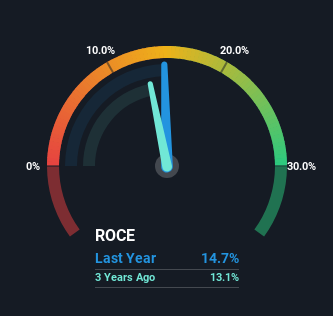Returns On Capital At General Mills (NYSE:GIS) Have Hit The Brakes
There are a few key trends to look for if we want to identify the next multi-bagger. In a perfect world, we'd like to see a company investing more capital into its business and ideally the returns earned from that capital are also increasing. Put simply, these types of businesses are compounding machines, meaning they are continually reinvesting their earnings at ever-higher rates of return. In light of that, when we looked at General Mills (NYSE:GIS) and its ROCE trend, we weren't exactly thrilled.
Understanding Return On Capital Employed (ROCE)
For those who don't know, ROCE is a measure of a company's yearly pre-tax profit (its return), relative to the capital employed in the business. To calculate this metric for General Mills, this is the formula:
Return on Capital Employed = Earnings Before Interest and Tax (EBIT) ÷ (Total Assets - Current Liabilities)
0.15 = US$3.7b ÷ (US$33b - US$7.9b) (Based on the trailing twelve months to February 2025).
Therefore, General Mills has an ROCE of 15%. In absolute terms, that's a satisfactory return, but compared to the Food industry average of 11% it's much better.
View our latest analysis for General Mills

In the above chart we have measured General Mills' prior ROCE against its prior performance, but the future is arguably more important. If you're interested, you can view the analysts predictions in our free analyst report for General Mills .
What The Trend Of ROCE Can Tell Us
Things have been pretty stable at General Mills, with its capital employed and returns on that capital staying somewhat the same for the last five years. It's not uncommon to see this when looking at a mature and stable business that isn't re-investing its earnings because it has likely passed that phase of the business cycle. So don't be surprised if General Mills doesn't end up being a multi-bagger in a few years time. With fewer investment opportunities, it makes sense that General Mills has been paying out a decent 57% of its earnings to shareholders. Given the business isn't reinvesting in itself, it makes sense to distribute a portion of earnings among shareholders.
What We Can Learn From General Mills' ROCE
We can conclude that in regards to General Mills' returns on capital employed and the trends, there isn't much change to report on. And with the stock having returned a mere 12% in the last five years to shareholders, you could argue that they're aware of these lackluster trends. So if you're looking for a multi-bagger, the underlying trends indicate you may have better chances elsewhere.
One more thing: We've identified 2 warning signs with General Mills (at least 1 which is significant) , and understanding these would certainly be useful.
While General Mills isn't earning the highest return, check out this free list of companies that are earning high returns on equity with solid balance sheets.
Have feedback on this article? Concerned about the content? Get in touch with us directly. Alternatively, email editorial-team (at) simplywallst.com.
This article by Simply Wall St is general in nature. We provide commentary based on historical data and analyst forecasts only using an unbiased methodology and our articles are not intended to be financial advice. It does not constitute a recommendation to buy or sell any stock, and does not take account of your objectives, or your financial situation. We aim to bring you long-term focused analysis driven by fundamental data. Note that our analysis may not factor in the latest price-sensitive company announcements or qualitative material. Simply Wall St has no position in any stocks mentioned.
 Wall Street Journal
Wall Street Journal